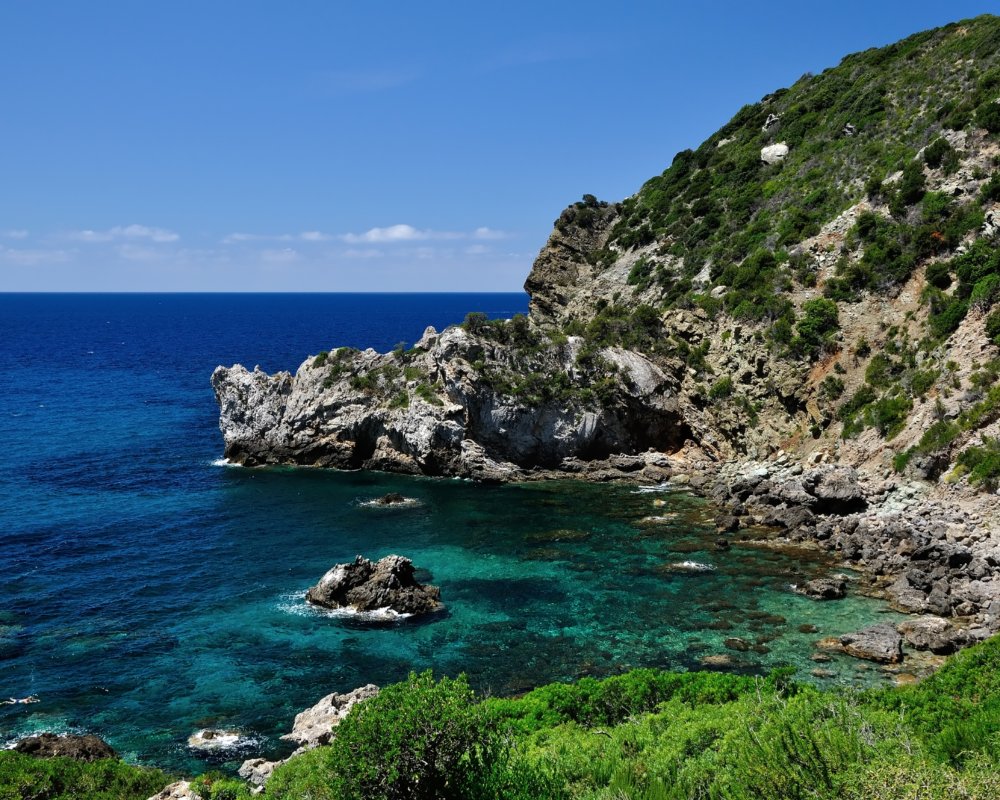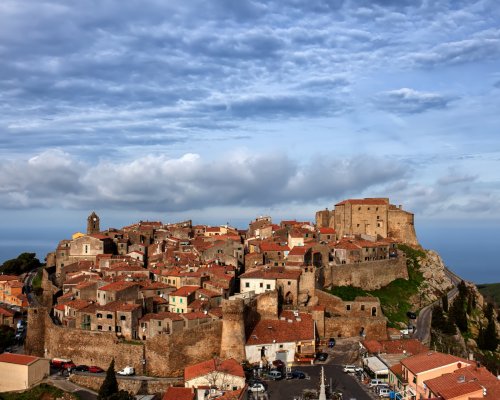A walk by the sea and along ancient pathways
Its austere, granite profile stands opposite the Argentario promontory, surrounded by the Tyrrhenian Sea and covered in Mediterranean scrub. This is Isola del Giglio, with its unspoilt landscape made up of cliffs and small bays overlooking waters so rich in underwater life.
The paths on Giglio unfold across 21 square kilometres, winding through high plains covered in shrubs and olive trees and snaking 500 metres up to Poggio della Pagana, from where the view ranges from the Tuscan coast to the islands of Elba, Giannutri and Montecristo. From the dock at Giglio Porto, a small seaside village surrounded by hills that are dotted with vineyards, the road begins that leads to the other end of the island. The climb is quite difficult on the way to Giglio Castello, home to a fortified village surrounded by towers and walls built by the Aldobrandesca family. Campese is located on the western slope, the island’s resort town, nestled in the middle of a sheltered bay, from where you can admire the splendid Punta Faraglione.
Let’s begin this excursion immersed in Giglio’s landscape, with a hike through three of the island’s towns and which offers plenty of opportunities for great views of the varied nature of this wild corner of Tuscany. Dirt paths and mule tracks form the ancient routes that were once used by island locals for moving between the fields both on foot and atop animals. Visits are ideal in the autumn, thanks to its mild climate, and in the spring, when the flowers are in full bloom.
Begin in Giglio Porto, following a brief stretch of road that runs alongside the beaches on the south-western slope. After leaving the provincial road for Castello, there will be a quick climb up beside the Cannelle Bay, offering splendid views of the coast. A small deviation will lead you to the cliffs at Cala Smeralda. From Cannelle, go back the way you came until you reach Giglio Porto. From here, take the steep via del Castello toward Monticello, where path 1 begins, the ancient route between the two towns. To walk through the oak forest, you’ll take a mule track paved with stones and stairs. Keep heading up, where the Arenella Bay and the mainland will come into view as you reach the walls surrounding Castello.
Begin in Giglio Porto, following a brief stretch of road that runs alongside the beaches on the south-western slope. After leaving the provincial road for Castello, there will be a quick climb up beside the Cannelle Bay, offering splendid views of the coast. A small deviation will lead you to the cliffs at Cala Smeralda. From Cannelle, go back the way you came until you reach Giglio Porto. From here, take the steep via del Castello toward Monticello, where path 1 begins, the ancient route between the two towns. To walk through the oak forest, you’ll take a mule track paved with stones and stairs. Keep heading up, where the Arenella Bay and the mainland will come into view as you reach the walls surrounding Castello.
Once you’ve conquered the 400 metres to Giglio Castello, stroll through the town’s narrow streets, observing the houses surrounded by the imposing Pisan walls. In the shade of the Rocca Aldobrandesca, built as a defense fortress, you can enjoy a glass of Ansonaco, the island’s esteemed wine, characterized by an amber colour and strong taste, before setting off for Campese. Take path 17 from the small piazza with the Giglio fountain: moving down the western slope of the island, the route heads in the direction of the Campese bay as it passes through ancient terraces. Miners used to come through here every day on their way to work at the Franco di Campese mine, where pyrite was extracted. Cross Valle del Molino, followed by an oak forest, ideal when you need a bit of shade on hot summer days.
Near Campese, you’ll want to stray about 10 minutes (600 metres) off the path to visit Cala dell’Allume, which boasts intense colours thanks to the wealth of iron that was once extracted right here in this little bay.
Once you’ve conquered the 400 metres to Giglio Castello, stroll through the town’s narrow streets, observing the houses surrounded by the imposing Pisan walls. In the shade of the Rocca Aldobrandesca, built as a defense fortress, you can enjoy a glass of Ansonaco, the island’s esteemed wine, characterized by an amber colour and strong taste, before setting off for Campese. Take path 17 from the small piazza with the Giglio fountain: moving down the western slope of the island, the route heads in the direction of the Campese bay as it passes through ancient terraces. Miners used to come through here every day on their way to work at the Franco di Campese mine, where pyrite was extracted. Cross Valle del Molino, followed by an oak forest, ideal when you need a bit of shade on hot summer days.
Near Campese, you’ll want to stray about 10 minutes (600 metres) off the path to visit Cala dell’Allume, which boasts intense colours thanks to the wealth of iron that was once extracted right here in this little bay.
From Campese, wrap up your east-west hike at Punta Faraglione, one of the most evocative places on the entire island. Following the mostly flat coast, the path leads to two sites that are ideal for staying cool in the summer: the Pertuso and Pozzarelli beaches. Leave from the Medici tower in Campese, built in 1700 to watch over the fishing activity and later used as a stronghold against pirate attacks. Walk across the beach that juts out in front of the tower until you reach a small pier where ships transporting minerals used to dock. Following the directions for path 15, head into the woods. You can quickly reach Cala del Petroso, while the path for Faraglione continues beside the coast, with Cala dei Pozzarelli on the left. Moving along the cliff, you’ll come close to a panoramic viewing point located right in front of the Faraglione, our final destination.
To return, head back the way you came until Campese, from where you can grab the bus that goes to Giglio Punto.
From Campese, wrap up your east-west hike at Punta Faraglione, one of the most evocative places on the entire island. Following the mostly flat coast, the path leads to two sites that are ideal for staying cool in the summer: the Pertuso and Pozzarelli beaches. Leave from the Medici tower in Campese, built in 1700 to watch over the fishing activity and later used as a stronghold against pirate attacks. Walk across the beach that juts out in front of the tower until you reach a small pier where ships transporting minerals used to dock. Following the directions for path 15, head into the woods. You can quickly reach Cala del Petroso, while the path for Faraglione continues beside the coast, with Cala dei Pozzarelli on the left. Moving along the cliff, you’ll come close to a panoramic viewing point located right in front of the Faraglione, our final destination.
To return, head back the way you came until Campese, from where you can grab the bus that goes to Giglio Punto.


